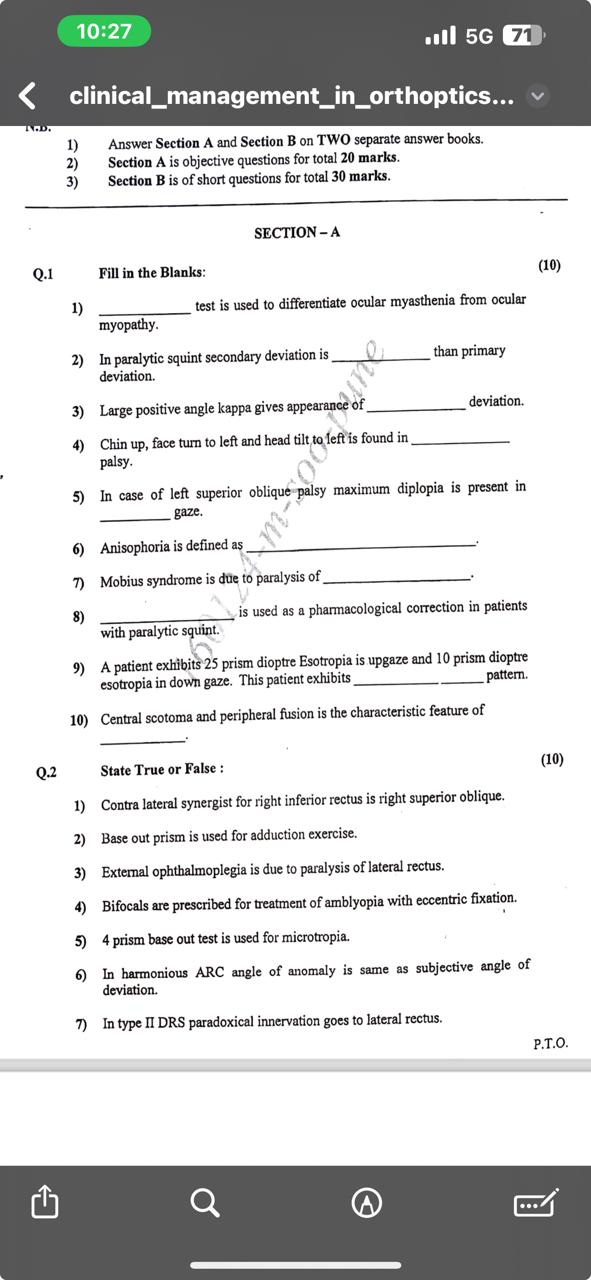Fill in the Blanks: 1) ____________ test is used to differentiate ocular myasthenia from ocular myopathy. 2) In paralytic squint secondary deviation is ____________ than primary de... Fill in the Blanks: 1) ____________ test is used to differentiate ocular myasthenia from ocular myopathy. 2) In paralytic squint secondary deviation is ____________ than primary deviation. 3) Large positive angle kappa gives appearance of ____________ deviation. 4) Chin up, face turn to left and head tilt to left is found in ____________ palsy. 5) In case of left superior oblique palsy maximum diplopia is present in ____________ gaze. 6) Anisophoria is defined as ______________________________. 7) Mobius syndrome is due to paralysis of ______________________________. 8) ____________ is used as a pharmacological correction in patients with paralytic squint. 9) A patient exhibits 25 prism dioptre Esotropia is upgaze and 10 prism dioptre esotropia in down gaze. This patient exhibits ____________________ pattern. 10) Central scotoma and peripheral fusion is the characteristic feature of ____________. State True or False: 1) Contra lateral synergist for right inferior rectus is right superior oblique. 2) Base out prism is used for adduction exercise. 3) External ophthalmoplegia is due to paralysis of lateral rectus. 4) Bifocals are prescribed for treatment of amblyopia with eccentric fixation. 5) 4 prism base out test is used for microtropia. 6) In harmonious ARC angle of anomaly is same as subjective angle of deviation. 7) In type II DRS paradoxical innervation goes to lateral rectus.

Understand the Problem
The question is part of an examination paper related to ophthalmology, specifically focusing on clinical management in orthoptics. It consists of fill-in-the-blank questions and True/False statements that test the knowledge of various concepts related to ocular conditions and treatments.
Answer
1) Tensilon test, 2) greater, 3) outward, 4) right superior oblique, 5) down and right, 6) a difference in the angle of deviation between two eyes in different gazes, 7) CN VI (abducens nerve) and CN VII (facial nerve), 8) Botox, 9) A pattern, 10) microtropia. True or False: 1) False, 2) False, 3) False, 4) False, 5) True, 6) True, 7) True
The final answers are: 1) Tensilon test 2) greater 3) outward 4) right superior oblique 5) down and right 6) a difference in the angle of deviation between two eyes in different gazes 7) CN VI (abducens nerve) and CN VII (facial nerve) 8) Botox 9) A pattern 10) microtropia State True or False: 1) False 2) False 3) False 4) False 5) True 6) True 7) True
Answer for screen readers
The final answers are: 1) Tensilon test 2) greater 3) outward 4) right superior oblique 5) down and right 6) a difference in the angle of deviation between two eyes in different gazes 7) CN VI (abducens nerve) and CN VII (facial nerve) 8) Botox 9) A pattern 10) microtropia State True or False: 1) False 2) False 3) False 4) False 5) True 6) True 7) True
More Information
Ocular myasthenia gravis can be diagnosed using the Tensilon test, which shows improvement in muscle strength after administration. Positive angle kappa can give an outward deviation appearance - a common finding.
Sources
- Video-Oculography for the Diagnosis of Ocular Myasthenia Gravis - ncbi.nlm.nih.gov
- Ocular Myasthenia Gravis - Brigham and Women's Hospital - brighamandwomens.org
- Strabismus (Squint) | Ento Key - entokey.com
AI-generated content may contain errors. Please verify critical information